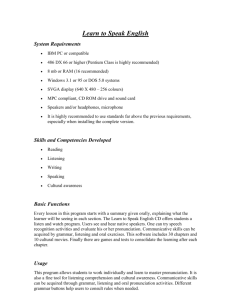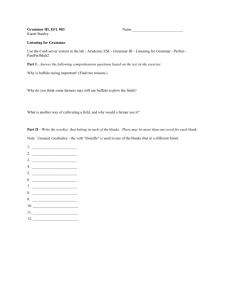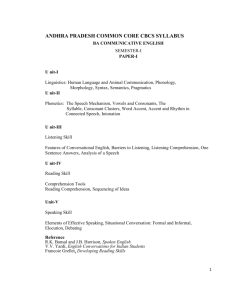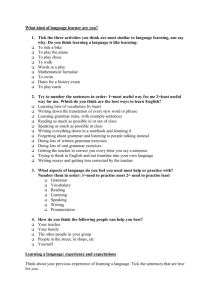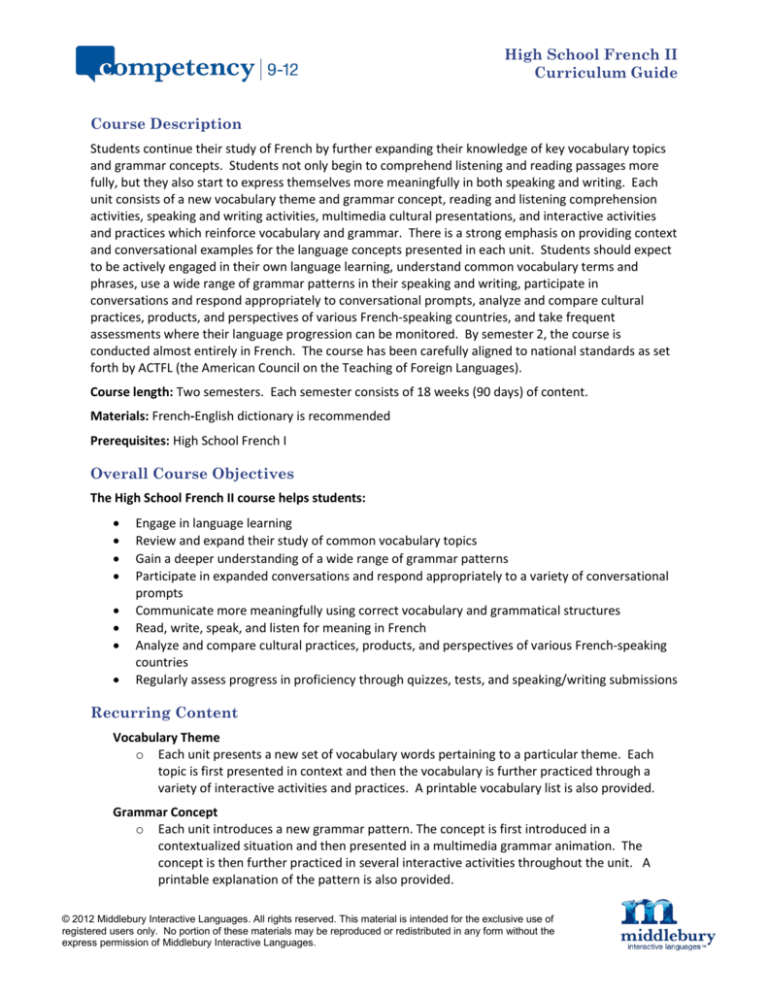
High School French II
Curriculum Guide
Course Description
Students continue their study of French by further expanding their knowledge of key vocabulary topics
and grammar concepts. Students not only begin to comprehend listening and reading passages more
fully, but they also start to express themselves more meaningfully in both speaking and writing. Each
unit consists of a new vocabulary theme and grammar concept, reading and listening comprehension
activities, speaking and writing activities, multimedia cultural presentations, and interactive activities
and practices which reinforce vocabulary and grammar. There is a strong emphasis on providing context
and conversational examples for the language concepts presented in each unit. Students should expect
to be actively engaged in their own language learning, understand common vocabulary terms and
phrases, use a wide range of grammar patterns in their speaking and writing, participate in
conversations and respond appropriately to conversational prompts, analyze and compare cultural
practices, products, and perspectives of various French-speaking countries, and take frequent
assessments where their language progression can be monitored. By semester 2, the course is
conducted almost entirely in French. The course has been carefully aligned to national standards as set
forth by ACTFL (the American Council on the Teaching of Foreign Languages).
Course length: Two semesters. Each semester consists of 18 weeks (90 days) of content.
Materials: French-English dictionary is recommended
Prerequisites: High School French I
Overall Course Objectives
The High School French II course helps students:
Engage in language learning
Review and expand their study of common vocabulary topics
Gain a deeper understanding of a wide range of grammar patterns
Participate in expanded conversations and respond appropriately to a variety of conversational
prompts
Communicate more meaningfully using correct vocabulary and grammatical structures
Read, write, speak, and listen for meaning in French
Analyze and compare cultural practices, products, and perspectives of various French-speaking
countries
Regularly assess progress in proficiency through quizzes, tests, and speaking/writing submissions
Recurring Content
Vocabulary Theme
o Each unit presents a new set of vocabulary words pertaining to a particular theme. Each
topic is first presented in context and then the vocabulary is further practiced through a
variety of interactive activities and practices. A printable vocabulary list is also provided.
Grammar Concept
o Each unit introduces a new grammar pattern. The concept is first introduced in a
contextualized situation and then presented in a multimedia grammar animation. The
concept is then further practiced in several interactive activities throughout the unit. A
printable explanation of the pattern is also provided.
© 2012 Middlebury Interactive Languages. All rights reserved. This material is intended for the exclusive use of
registered users only. No portion of these materials may be reproduced or redistributed in any form without the
express permission of Middlebury Interactive Languages.
Presentation of Culture through Culture Videos
o In each unit students learn about various cultural aspects (e.g. practices, products, and
perspectives) of a French-speaking country through short video presentations.
“Out of Seat” Activities
o Several times during the year, students are given opportunities to use the language
“outside” the course. These are specific assignments directing students to interact in a
genuine way with the French language or French-speaking cultures.
Speaking and Writing Activities
o Students complete speaking and writing activities in each unit. These activities give students
a chance to become more familiar with the speaking and writing patterns of French by
applying them in communicative situations.
Listening and Reading Comprehension Activities
o Each unit contains both listening and reading comprehension practices. They are based on
the vocabulary, grammar, or culture concepts presented that unit and challenge students to
identify the main ideas and significant details of the listening/reading excerpts.
Assessments
o Listening and reading comprehension quizzes verify that students comprehend the main
ideas and/or significant details of target language passages or conversations.
o Culture comprehension quizzes verify that students have understood important concepts
presented in the culture presentations.
o Unit tests assess students’ mastery of the vocabulary words and grammar concepts
presented that unit. Each unit test also includes reading and listening comprehension
questions and an oral or written assessment.
o Midterm and Semester Exams are comprehensive in nature. Not only do they assess
students’ knowledge of the language, but they also assess students’ ability to produce the
language in a communicative way. Midterms and Semester Exams include both oral and
written assessments.
“Life-long Learner” Assignments
o Each semester students are required to create a plan for incorporating French into their
daily lives. They accomplish this by outlining the long-term benefits of learning French, by
making goals for what they want to accomplish with their mastery of the language, and by
creating a plan for accomplishing their goals.
“Explore” Activities
o These activities help students develop a more profound understanding of French-speaking
countries and cultures.
“Webquest” Activities
o These special activities provide students the opportunity to link out to authentic sources of
language on the Internet. Students are given practical tasks where they must use their
language to accomplish the assignment.
Discussion Board Activities
o There is one discussion board activity in each semester. These activities provide
opportunities for students to interact with other students and practice their new language.
Competency-High School French II Curriculum Guide
© 2012 Middlebury Interactive Languages
Page 2
Journal
o Journal assignments allow students to make cultural comparisons, reinforce new vocabulary
and grammar patterns, and practice communicating in the language.
Pronunciation
o Pronunciation lessons are presented in short animation videos. These videos focus on the
unique sounds of the language. Follow-up activities throughout the unit provide additional
practices for students to improve their pronunciation skills.
Competency-High School French II Curriculum Guide
© 2012 Middlebury Interactive Languages
Page 3
Course Scope and Sequence
Semester 1
Unit 1
Vocabulary
Grammar
Culture
Pronunciation
Verb review
Regular Verbs review
French Polynesia:
Introduction
Word-final
Consonants:
When to
pronounce
“-ent”
Present Tense
The Imperative
Unit 2
Descriptions
Irregular Adjectives
Adjective Placement
The Cultural
Festival of Heiva
Possessive Adjectives
Unit 3
Food
The Past Tense (passé
composé)
Polynesian Cuisine
Unit 4
Professions
The Near Future (futur
proche)
The Tahitian
Language
Masculine and
Feminine
Adjective
Endings
Double Verb sentences
Unit 5
At a Restaurant
Negative Expressions
Tahitian History
La liaison
The Partitive Article
Unit 6
Extended Family
Direct Object Pronouns
Stress (Tonic) Pronouns
Monoï, an
Ambassador of
Beauty and
Health
Unit 7
Health (talking with
doctors)
Indirect Object
Pronouns
The Painter Paul
Gauguin
Unit 8
In the City
Prepositions
Tikis
Unit 9 Midterm Review and Test
Music
Forms of quel and
Unit 10
lequel
Morocco:
Introduction
Unit 11
Pastimes
The Imperfect
The Souk, a
Traditional
Marketplace
Unit 12
Holidays and
Celebrations
The Imperfect vs. the
Past Tense
Moroccan Cuisine
Unit 13
Countries and
Nationalities
Prepositions with
Proper Place Names
Multilingual
Morocco
Unit 14
Vacation
The Expressions depuis,
il y a, and pendant
Moroccan
Weddings
Unit 15
The Body
Reflexive Verbs
Moroccan History
Competency-High School French II Curriculum Guide
© 2012 Middlebury Interactive Languages
The Open and
Closed “u”
Sounds
The Open and
Closed “e”
Sounds
The e caduc (schwa)
part 1:
Identification
The e caduc (schwa)
part 2: When
they drop.
Page 4
Semester 1 (Continued)
Vocabulary
Grammar
Culture
Pronunciation
Unit 16
Clothing
Reflexive Verbs in the
passé composé
La fantasia, an
Equestrian
Tradition
Unit 17
School
The Pronoun y
The Tagine
Pronouncing
Numbers
Stress and
Intonation
Unit 18 Final Review and Test
Semester 2
Unit 19
Technology
The Future (futur
simple)
Switzerland:
Introduction
Unit 20
Expressions with the
verbs avoir and
être
The Expressions dès
que and quand
Skiing
Unit 21
Computers
Demonstrative
Adjectives
Swiss Chocolate
Unit 22
Love and Dating
(part 1)
Relative Pronouns (qui,
que, and dont)
Switzerland: an
Independent
Nation
Unit 23
Work
Adverbs
Yodeling
Unit 24
Measurements and
Quantities
The Pronoun en
Huitante: Counting
in Switzerland
Unit 25
Love and Dating
(part 2)
Pronoun Review and
Pronoun Order
Review
The Author JeanJacques
Rousseau
Unit 26
Transportation
The Comparative and
the Superlative
The Visual Arts in
Switzerland
Unit 27 Midterm Review and Test
Social Issues
Conjunctions
Unit 28
The Open and
Closed “o”
Sounds
Nasal Vowels
Senegal:
Introduction
Unit 29
At Home
The Conditional Tense
Les griots:
Storytellers,
Musicians,
Teachers.
Unit 30
Shopping and
Money
Si clauses in the Future
and Conditional
Senegalese Cuisine
Unit 31
Nature
Demonstrative
Pronouns
The Dakar
Unit 32
False Cognates
The Subjunctive – An
Introduction
The French
Language in
Senegal
Competency-High School French II Curriculum Guide
© 2012 Middlebury Interactive Languages
The Letter “s”
The Open and
Closed “w”
Sounds
The Open and
Closed “eu”
Sounds
Page 5
Semester 2 (Continued)
Vocabulary
Grammar
Culture
Pronunciation
Unit 33
Giving Advice
The Subjunctive vs. the
Infinitive (il faut vs. il
faut que)
History of Senegal
Review: The Open
and Closed “e”
Sounds
Unit 34
Les mots-liens
Mots-liens and
Paragraph-level
Speech
Léopald Sédar
Senghor
Unit 35
Verb Review
Overview of Verb
Tenses
The Djembe
Review: Open and
Closed Sounds
Unit 36 Final Review and Test
Competency-High School French II Curriculum Guide
© 2012 Middlebury Interactive Languages
Page 6

